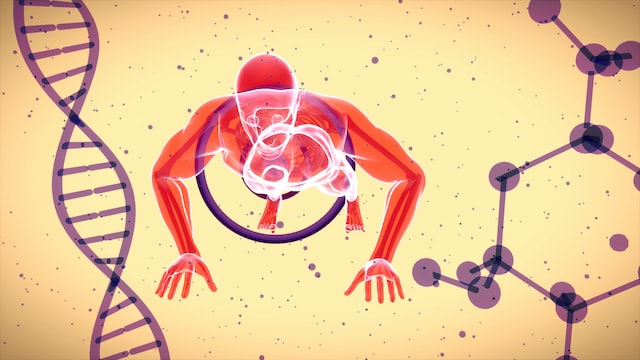A disease is a specific medical condition that affects the normal functioning of the body, while a syndrome refers to a group of symptoms and physical characteristics that occur together and suggest the presence of a particular medical condition or underlying cause.
What is a syndrome?
(Photo by julien Tromeur on Unsplash )

A syndrome is a collection of symptoms and physical characteristics that tend to occur together and suggest the presence of a particular medical condition or underlying cause. These symptoms and characteristics may be physiological, psychological, or behavioral in nature, and they are often distinctive and recognizable to medical professionals. A syndrome may be caused by a specific disease, genetic disorder, or environmental factor, and may affect various systems of the body or particular organs. Some examples of syndromes include Down syndrome, Turner syndrome, and chronic fatigue syndrome. Diagnosis of a syndrome may involve a range of medical tests, including blood tests, imaging studies, and genetic testing, and treatment may depend on the underlying cause of the syndrome.
What is a disease?
(Photo by Accuray on Unsplash )

A disease is a specific medical condition that affects the normal functioning of the body. Diseases can be caused by various factors such as pathogens (like viruses, bacteria, and parasites), genetic mutations, environmental factors, and lifestyle choices.
Diseases can affect various parts and systems of the body, and can cause a wide range of symptoms and complications. These symptoms can be physical (such as pain, weakness, or fever), psychological (such as depression or anxiety), or behavioral (such as changes in eating or sleeping habits). Some diseases can be acute, meaning they occur suddenly and are short-lived, while others can be chronic, meaning they last for a long time or are recurring.
Disease diagnosis involves a range of medical tests, including physical examinations, blood tests, imaging studies, and biopsies. Treatment for a disease may depend on the underlying cause and severity of the condition, and can include medication, surgery, lifestyle changes, and other interventions.
Examples of diseases include infectious diseases like COVID-19, chronic diseases like diabetes and heart disease, and genetic diseases like cystic fibrosis and sickle cell anemia. Overall, diseases are a major focus of medical research, prevention, and treatment, and efforts are ongoing to identify new treatments and cures for a wide range of conditions.
The difference between syndrome and disease
The main difference between a syndrome and a disease is that a disease is a specific medical condition with a known cause, whereas a syndrome is a collection of symptoms and physical characteristics that tend to occur together and suggest the presence of a particular medical condition or underlying cause.
A disease can be diagnosed based on specific signs and symptoms, as well as medical tests such as blood tests, imaging studies, and biopsies. A specific cause can often be identified, whether it is a pathogen, genetic mutation, environmental factor, or other factor. Treatment for a disease is often focused on addressing the underlying cause and managing symptoms.
A syndrome, on the other hand, is not a specific diagnosis, but rather a set of symptoms and physical characteristics that tend to occur together. Syndromes can have multiple possible causes, and diagnosis may involve ruling out other conditions through medical tests. Treatment for a syndrome often focuses on managing symptoms and addressing underlying conditions, if they can be identified.
A disease is a specific medical condition with a known cause, while a syndrome is a set of symptoms and physical characteristics that suggest the presence of a particular condition, but may have multiple possible causes.
Examples of syndromes
There are many different syndromes that can be classified as a disease. For example, Down syndrome is a genetic disorder caused by the presence of an extra chromosome. This syndrome can cause mental retardation, physical abnormalities, and developmental delays. Other examples of syndromes include:
Turner syndrome: A genetic disorder that affects only females and causes short stature, reduced fertility, and heart defects.
Klinefelter syndrome: A genetic disorder that affects males and causes enlarged breasts, reduced fertility, and intellectual disability.
Williams syndrome: A rare genetic disorder that causes facial deformities, cardiovascular problems, and learning disabilities.
Examples of diseases
A syndrome is a collection of symptoms that together indicate a particular disease. A disease is a specific condition that has its own specific cause.
Below are some examples of diseases:
Heart disease: Heart disease is a term used to describe a range of conditions that affect the heart. It includes coronary heart disease, heart failure, and congenital heart defects.
Alzheimer’s disease: Alzheimer’s disease is the most common form of dementia, a group of conditions that affect the brain. It causes problems with memory, thinking, and behavior.
Diabetes: Diabetes is a condition in which the body does not properly process glucose, a type of sugar. This can lead to high blood sugar levels and damage to various organs in the body over time.
What makes a disease a syndrome?
A disease becomes a syndrome when it is characterized by a specific set of signs and symptoms that tend to occur together, but the underlying cause of those signs and symptoms is not fully understood or cannot be explained by a single identifiable cause.
A syndrome is often used to describe a set of symptoms and physical characteristics that suggest the presence of a particular medical condition or underlying cause, but a specific diagnosis cannot be made based on those symptoms alone. For example, chronic fatigue syndrome is a syndrome characterized by severe fatigue that cannot be explained by any known medical condition, and the underlying cause of the syndrome is not fully understood.
In summary, a disease becomes a syndrome when it is characterized by a specific set of signs and symptoms that tend to occur together, but the underlying cause of those signs and symptoms cannot be fully explained by a single identifiable cause.
What is the most common syndrome?
It is difficult to determine the most common syndrome because there are many different syndromes, some of which are relatively rare, while others are more common. Some common syndromes include:
Down syndrome: This is a genetic disorder caused by an extra chromosome 21, resulting in developmental and intellectual disabilities. It is one of the most common genetic disorders, occurring in approximately 1 in 700 births.
Irritable bowel syndrome (IBS): This is a chronic gastrointestinal disorder characterized by symptoms such as abdominal pain, bloating, and changes in bowel habits. It is estimated to affect up to 10-15% of the population.
Chronic fatigue syndrome (CFS): This is a syndrome characterized by severe fatigue that cannot be explained by any known medical condition. It is estimated to affect up to 2.5 million people in the United States.
Tourette syndrome: This is a neurological disorder characterized by repetitive, involuntary movements and vocalizations called tics. It is estimated to affect up to 1% of the population.
The prevalence of a syndrome can vary depending on factors such as genetics, environment, and lifestyle.
Is a genetic syndrome a disease?
A genetic syndrome can be considered a type of disease. A genetic syndrome is a condition that is caused by changes or mutations in genes, and it often involves a specific set of signs and symptoms that tend to occur together. These genetic mutations can be inherited from one or both parents or can occur spontaneously. Some genetic syndromes are relatively mild, while others can be more severe and can significantly impact a person’s health and quality of life.
In general, a disease is any abnormal condition or disorder that affects the body or mind and impairs normal functioning. A genetic syndrome fits this definition because it can cause physical or mental impairments, but it is important to note that not all diseases are genetic in nature. There are many different types of diseases, including infectious diseases, autoimmune diseases, and degenerative diseases, that are not caused by genetic mutations.
What causes a syndrome?
A syndrome is typically caused by a combination of genetic, environmental, and lifestyle factors. In some cases, the underlying cause of a syndrome may be unknown, but in other cases, it may be attributed to a specific genetic mutation or medical condition.
Genetic factors play a significant role in the development of many syndromes. For example, Down syndrome is caused by an extra copy of chromosome 21, which leads to developmental and intellectual disabilities. Other syndromes, such as Marfan syndrome and Turner syndrome, are caused by mutations in specific genes.
Environmental factors can also contribute to the development of a syndrome. For example, exposure to certain chemicals or toxins during pregnancy can increase the risk of a child developing a syndrome such as fetal alcohol syndrome. In some cases, a syndrome may be triggered by an infection, injury, or other external factor.
Lifestyle factors, such as diet, exercise, and stress, can also play a role in the development of a syndrome. For example, metabolic syndrome, which is characterized by a cluster of conditions such as high blood pressure, high blood sugar, and excess body fat around the waist, is often associated with a sedentary lifestyle and a diet high in sugar and processed foods.
The cause of a syndrome can vary depending on the specific condition and individual factors. It often involves a complex interplay of genetic and environmental factors.
Can syndromes be cured?
The short answer is that syndromes can be cured, but the process is often long and complicated. There are many different types of syndromes, and each one has its own set of symptoms and causes. Treatment usually involves a combination of medication, therapy, and lifestyle changes. In some cases, surgery may also be necessary.
Featured Image By – Photo by Towfiqu barbhuiya on Unsplash








